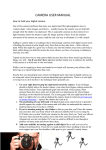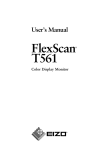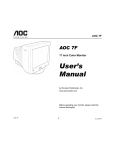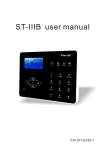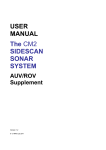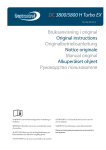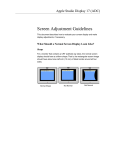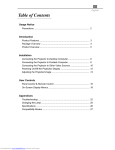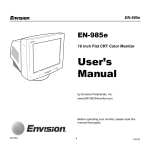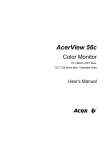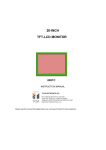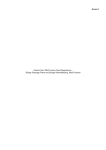Download 2107e - Mitsubishi Electric Australia
Transcript
Unpacking the Package Chapter 1 Unpacking the Package Check following items. If they are missing or damaged, consult your place of purchase immediately. 2107e color monitor Power cord ? 15-pin D-SUB signal cable Users manual Macintosh adapter Locate the model name and the serial number labeled on the back of your monitor. Write down the related information of your monitor and dealer in the space on page iii for future reference. : 1 Chapter 1 Features Super-fine Dot Pitch With 0.25mm super-fine dot pitch and anti-static coating, 2107e color monitors offer strikingly sharp and high resolution image up to 1600 x 1200. Wide Range AutoScan Horizontal frequency ranges from 30KHz to 107 KHz to support 1600 x 1200 @ 90Hz resolution. Flicker-Free design for vertical frequency of up to 160Hz. Auto key Pressing the Auto key, the monitor will automatically adjust displays size and position to the optimum. No re-configuration or adjustment is needed when a user changes display mode. Low radiation 2107e meets strictest low radiation regulations of MPRII. Users and Environment 2107e is produced by the ISO 14001 certified manufacturer, and in compliance with the global environmental labelling scheme- MPRII. Plug’n Play Compatibility Supporting VESA DDC I and DDC 2B standards, 2107e is compatible with Plugn Play feature of Window ® 95 and Window 98® : 2 Unpacking the Package Power Management The Power management of this monitor complies with these VESA power saving modes: Mode Power Horizontal Consumption Syne On Stand-by Suspend Off Overide Normal < 15 W < 15 W <5W Normal On Off On Off Off Vertical Sync LED On On Off Off Off Green Amber Amber Amber Blinking Green Factory Preset Timings Resolution 640 640 640 800 x x x x 400 480 480 600 1024 x 768 1024 x 768 1280 x 1024 1280 x 1024 1600 x 1200 1600 x 1200 Vertical Frequency (Hz) Horizontal Frequency (KHz) 70 60 75 75 31.47 31.47 37.50 46.88 75 85 75 85 75 85 60.02 68.68 79.98 91.15 93.75 106 ** All above timings are non-Interlace timings. : 3 Chapter 2 Chapter 2 Installing the Monitor This monitor is equipped with an autosensing universal compatible power supply for voltage ranges 100-120/200-240V AC, 50~60Hz.. Please confirm the line voltage designation at the rear panel of the monitor before connecting the machine. 1) Make sure that the system power is turned off. 2) Please refer to the instructions below to connect the signal cable through D-SUB or BNC. 3) Connect the power cord to the monitor and attach it to power source. 4) Turn on the computer and the monitor. : 4 Installing the Monitor Connecting the Signal Cable Your 2107e provides both D-SUB and BNC signal connectors. The D-SUB or BNC signals can automatically be detected by its microprocessor. ✏ Connecting through D-SUB signal connector 1) Make sure that the system power is turned off. 2) Connect the computer end of the D-SUB cable to the 15-pin output connector on the video board of your computer. 3) Connect the monitor end of the D-SUB cable to the D-SUB receptacle on the back of the monitor. : 5 Chapter 2 ✏ Connecting to An Apple If you connect the monitor to an Apple Macintosh through a D-Sub cable, you need to add the Macintosh adapter to connect the video signal port of your computer and the monitor signal cable. Before connecting the adapter please refer to the user's guide of the adapter to set the switches of the adapter. : 6 Installing the Monitor ✏ Connecting through BNC Signal Connector 1) Make sure that the system power is turned off. 2) Connect the computer end of the BNC cable to the output connector on the video board of your computer. 3) Connect the monitor end of the BNC cable to the BNC receptacle on the back of the monitor. : 7 Chapter 3 Chapter 3 A Look at the Control Panel Auto key Exit Menu Enter Auto Exit l l l l Menu Enter Menu key : enters or changes Main menus. There are three main menus. Enter key : enters sub-menus or selects items. Exit key : goes back to main menus (auto save), or leaves OSD. & key : scrolls the light coloured bar up or down and represents HOT KEY for brightness adjustment. l & key : scrolls the light coloured bar left or right and represents HOT KEY for contrast adjustment. l : 8 Auto key : is used for Fuzzy Automatic calibration adjustment. A Look at the Control Panel Making Adjustments Auto key(Fuzzy Auto Calibration ) Just push the Auto key, then the monitor will automatically adjust display's size and position to the optimum. No re-configuration or adjustment is needed when a user changes display mode. The Auto key function is different from "Reset" function. "Reset" function for display's geometry, size and position only works under the factory preset timings (please see page 3). The Auto key function will work under "ANY" display timings which 2107e can support. Hot Keys Press or Press or key to adjust contrast directly. key to adjust brightness directly. : 9 Chapter 3 OSD Operation 1) Press Menu key to enter or change Main menus (there are three main menus) 2) Press or keys to scroll light coloured bar to desired items. 3) Press Enter key to enter sub-menus. 4) Press , ( , ) key to do the adjustments. If the sub-menu contains 5) 6) ? multiple items. Press or keys to scroll light coloured bar to desired items. Then press or key to adjust as required. Press Exit key to save and return to main menus. Press Exit key to save and leave OSD Reset to the factory default settings, please see General Settings Reset and Color Temperature Reset. Main Menu 1 Display Control This main menu includes six items. Scroll the light coloured bar to desired items and press Enter to sub-menus. : 10 A Look at the Control Panel Luminance Contrast and Brightness adjustments Contrast adjusts the difference between the light and dark areas. Brightness adjusts the brightness of the display. Size & Position Display size and position adjustment : 11 Chapter 3 Hor. Position adjusts the horizontal position of the display. Hor. Size adjusts the width of the display. Ver. Position adjusts the vertical position of the display. Ver. Size adjusts the vertical height of the display. Geometry Advanced geometry adjustments Pincushion controls the straightness of the vertical edges of the display. Unbalance adjusts balance when the sides of display are bowed towards left or right Trapezoid makes the vertical edges of the display parallel. Parallelogram corrects image leaning left or right. Rotation corrects screen tilt. Top Corner adjusts the edges on the top corners of the screen image. : 12 Bottom Corner adjusts the edges on the bottom corners of the screen image. A Look at the Control Panel OSD Position OSD position adjustments adjusts the OSD menu position up. adjusts the OSD menu position down. adjusts the OSD menu position left. adjusts the OSD menu position right. Degauss Manual Degauss. To eliminate color shading or impurity induced by magnetism, press Enter to active Degauss function. Reset to Default Reset the monitor to the default factory settings including H/V position, H/V size, Pincushion, Unbalance, Trapezoid, Parallelogram, Rotation, Corner, H/V Convergence, H/V Moie and Moire. For preset timings, in order to reset to factory default values, press Enter. To reset color Temperature, plsease see page 15. : 13 Chapter 3 Main Menu 2 Color Control This main menu is defined as color weight adjustment. C1 ~ C5 are color storage areas, which are factory preset but can also be modified by user. The preset information as follows : Factory Default Color Temperature C1 9300K C2 C3 C4 C5 6500K 5500K 7100K 11500K Scroll the light coloured bar to desired color temperature, then press Exit to save the setting and leave OSD. Press Enter key to sub-menus and adjust RGB color weight. : 14 A Look at the Control Panel This sub-menu adjusts RGB (Red, Green, Blue) color weight. Press or keys to scroll light coloured bar to desired items then press or key to do the adjustments. ? To reset to factory default values, scroll light coloured bar to item Reset to Default”. “ Main Menu 3 Advanced Display Control This main menu includes six items, scroll light coloured bar to desired items. Press Enter key to enter sub-menus. : 15 Chapter 3 Convergence Horizontal & Vertical Convergence adjustment Hor. Convergence: adjusts Horizontal Convergence Ver. Convergence: adjusts Vertical Convergence Convergence is the monitor's ability to precisely illuminate specific phosphors and line them up properly in order to produce pure color. Displayed characters and images may appear fuzzy or have tinges of red , green, or blue if the electron beams do not converge correctly. 2107e offers a convergence adjustment feature. To properly adjust convergence, it is best to have an image that makes it easy to see any convergence error. A black background with white letters or lines is recommended. When adjusting convergence, look at the adjustment across the whole screen. When adjusting horizontal convergence, look at the left and right edges of vertical lines or characters. When adjusting vertical convergence, look at the top and bottom edges of horizontal lines or characters. The monitor is properly adjusted when the effects of red and blue tinges are minimized. ? ? : 16 The convergence adjustment adjusts the entire screen. It is not possible to limit adjustment to specific screen areas. Factory default setting values : 0 A Look at the Control Panel Moire Horizontal & Vertical Moire adjustment Horizontal Moire: adjusts horizontal Moire Vertical Moire: adjusts vertical Moire Moire refers to an interference pattern of dark wavy lines on the screen. It is an interference phenomenon caused by the relationship between the phosphor layout and the imaging signal. In fact, it is often considered an indication of good focus level. ? It is especially noticeable when using a light-gray or every-otherdot pattern. Moire cannot be eliminated. However, it can be reduced with the moire reduction feature. Moire can be reduced by adjusting the iscreen moire reduction function. Prior to adjustment, set the screen to a full white pattern so that moire will be visible. After this adjustment, make changes to a different screen background in order to reduce moire even further. ? If the picture is unstable when you adjust the moire reduction setting, over-adjustment has occured. Please lower the moire reduction setting level. (Factory default setting value : 0). : 17 Chapter 3 Language Select The sub-menu is defined as language selection and there are five languages to choose from. D-Sub BNC Input connector select. There are two kinds of input connectors for 2107e. One is a BNC connector, the other is a DB-15. The 2107e is capable of automatically detecting the type of connector used (either BNC or DB-15). If the two connectors are connected simultaneously, the user can select the desired connector. : 18 A Look at the Control Panel Purity Colour purity adjustment To adjust Purity, choose a full white picture and adjust to get a pure white picture at the corner of the screen image. Display Mode Current resolution, horizontal and vertical frequency status presentation. : 19 Chapter 3 Timing Setting By making adjustments to your video card settings, you can set the timing and the refresh rate according to your preferences. The monitor will automatically save the settings. Your monitor can accept a vertical frequency ranging from 50 Hz to 160 Hz and an horizontal frequency from 30 KHz to 107 KHz. However, due to different video card and resolution settings, we recommend that you do not exceed the maximum refresh rate, 160 Hz for vertical frequency and 107KHz for horizontal frequency to avoid possible damage to your monitor. Resolution ? 640 x 480 800 x 600 1024 x 768 1280 x 1024 Refresh Rate(Hz) 160 145 135 100 1600 x 1200 90 To set the timing and the refresh rate, please see the user's guide of your video card. : 20 Recommended Maximum Vertical A Look at the Control Panel Pin Assignments D-SUB Connectors Pin No Separate Signal Composite 1 2 3 4 5 6 7 8 9 10 11 Red Green Blue NC GND R-GND G-GND B-GND PC5V(For DDC) GND-SYNC GND Red Green Blue NC GND R-GND G-GND B-GND PC5V(For DDC) GND-SYNC GND Red Green + SYNC Blue NC GND R-GND G-GND B-GND PC5V(For DDC) GND-SYNC GND 12 13 14 15 DDC Data H-SYNC V-SYNC DDC Clock DDC Data H/V-SYNC Not Used DDC Clock DDC Data Not Used Not Used DDC Clock Sync-on-green : 21 Chapter 3 BNC Connectors Pin Assignment B G/SYNC R H/H+V separate Blue Green Red H-SYNC V V-SYNC : 22 Signal composite Blue Green Red H/V-SYNC NC sync-on-green Blue Green + SYNC Red NC NC A Look at the Control Panel Chapter 4 Troubleshooting Make sure that your monitor is properly installed. If you have encountered any trouble in using this product, for hardware installation problems, see Chapter 2, Installing the Monitor. If the problems persist, check this chapter for possible solutions. § If there is no picture on the screen, check: l Power outlet type. l Video sync signal. The video sync signal must be specified for the monitor. l Power saving mode. Press any key & use the mouse to deactivate the mode. l Signal cable connector pins. If pins are bent or missing, consult your dealer. § If the picture is scrolling or unstable, check: l l l l l l Signal connector pin assignments. Replace with a functional one if inoperative. Signal cable connector pins. If pins are bent or missing, consult your dealer. Graphics card. See if the settings are made properly. Scanning frequency. Change the settings of your graphics card to acceptable options Remove magnetic objects near the monitor. Over-adjusting moire reduction setting, please check the moire reduction setting level. See Chapter 3, A Look at the Control Panel. : 23 Chapter 4 § If the characters look dark, the picture is too small, too large or not centered etc. l Adjust related settings. See Chapter 3, A Look at the Control Panel. § If colors are impure. l Check signal cable connector pins. If pins are bent or missing, consult your dealer l Adjust the Purity setting. See Chapter 3, A Look at the Control Panel. Maintenance ✘ ✘ ✘ Do not expose the monitor to direct sunlight or heat. Do not spill liquid on the monitor. Do not attempt to open the monitor. You may be hurt by electric shock. For service, call your dealer. ✘ Do not use your monitor when magnets or electronic products are operating nearby. ✘ Do not use harsh chemicals or strong cleaning solvents to clean the monitor screen. Wipe it with mild solution applied on clean and soft cloth. ✘ Do not place anything on your monitor. Bad ventilation may elevate tempera ture within the monitor. + Need More Help? If your problems remain after checking this manual, please contact your place of purchase. : 24 Specifications Chapter 5 Specifications Picture Size Dot Pitch Surface/Transmission 21(53.34cm) diagonal 0.25mm dot pitch AR,AS/semi-tinted Maximum Viewable Size 20 (51cm) diagonal Video Input 15-pin, mini D-SUB Connector/BNC Connector Bandwidth 230MHz Display Area 380mm(H) x 285mm(V) (Preset) 408mm(H) x 306mm(V) (Full Scan) Power Supply(Universal) Input voltage Power consumption 100~120/200~240 VAC, 50~60 Hz (Universal compatible) 150Watts max./165 Watts max.(With USB) External Controls Power switch, Auto key auto-calibration, Contrast, Brightness, Horizontal Position, Horizontal Size, Ver tical Position, Ver tical Size, Pincushion, Unbalance, Trapezoid,Parallelogram, Rotation, Top Corner, Bot tom Corner, Color Weight, Degaussing, Horizontal Convergence, Vertical Convergence, Horizontal Moire, Vertical Moire, BNC and DB-15 Selection, Reset, Language Select, Purity Max. Resolution 1600 x 1200 : 25 Horizontal Frequency 30-107 KHz Vertical Frequency 50-160 Hz Dimensions (with stand) 508mm(W) x 515mm(H) x 512mm(D) Weight 29.4Kg Ambient Temperature Operating Storage +5C ~ +40C 0C ~ +60C Humidity Operating Storage 20% ~ 90% 10% ~ 90% Regulatory Compliance TÜV-GS, TÜV-ergo, C-tick, MPR-II : 26



























